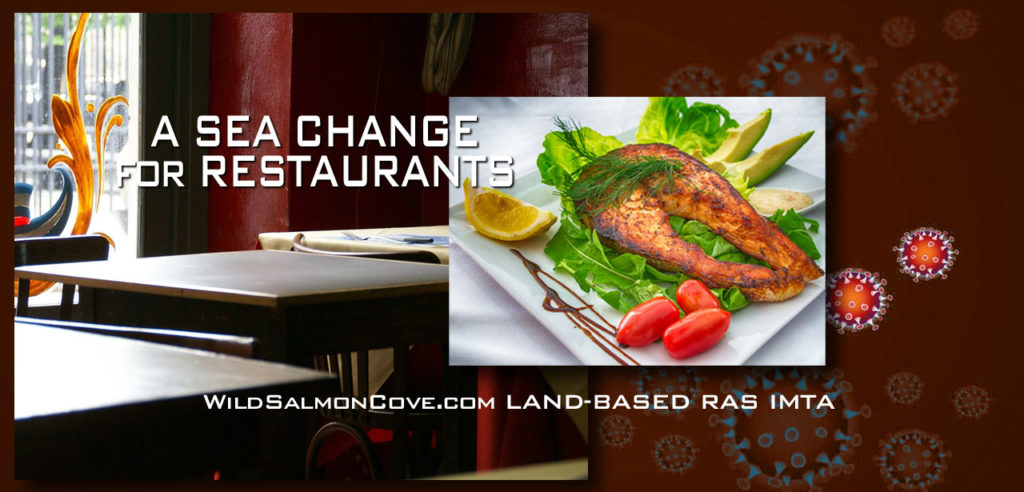Covid
Crystal
Ball
Gazing

Surviving a pandemic depends on your ability to adapt.
Under the shadow of Covid-19, health and business success is not about strength as much as you might think.
It hinges more on your capacity to change.
Restaurant customers in our pandemic era are hesitant, and highly vocal about not returning to spaces that can spread the novel coronavirus. Families and seniors are saying, “We’re not comfortable eating in restaurants until the science and medical community have coronavirus locked down with a vaccine.”
Middle ground demographics are also saying, “We’re learning to cook at home, and loving it!”
Now that they have time on their hands, many report that home cooking is easier than they thought it would be, and actually fun, plus it’s considerably cheaper!
WHAT!? Who knew that home cooking is cheaper and better for your health?
Considering that at least 70% of seafood is sold in restaurants, what does it mean to you?
Post-Covid, if cooking at home is fun and less expensive, how will restaurants lure customers back who are not only virus-nervous, but now also cost sensitive? It’s a double-edged sword when you consider restaurants are already pushing hard to open and make up for lost revenue, as are many customers who are also not working. We all clearly know that if there is NOT an IMMEDIATE second wave of covid deaths, younger demographics will quickly flood restaurants and bars, and what happens after that will be anyone’s guess.

Today’s question is, which restaurant in your area is willing to take the moral risk of going first? The difference this month is that now everyone knows the risk, and if you place your staff and customers in a dangerous environment, and someone is injured or worse, dies, be prepared for lawsuits. Insurance companies are already backing away from liability, which means you could be on your own.
Covid civil actions against seniors’ long term care facilities, insurance companies, and airlines are already ramping up. Restaurants won’t be far behind.
Safe dining is now an oxymoron and will be for quite some time. Most seafood entrepreneurs still don’t fathom the ramifications, with many mistakenly hoping we’ll eventually return to a “new” normal.
Businesses need to be more conscientious about WHOM in news media they believe. Trump isn’t exaggerating about fake news. Here’s an example of an industry news company using a misleading headline; “One in five Canadians say Covid-19 pandemic overblown: Poll”
The reality is that 4 out of 5 people feel that Covid-19 is NOT overblown, and that, is the critical stat of which they do not want you to focus. Context is crucial to understanding. Triple check everything you believe to be true before you make a decision regarding the fate of your business. The poll btw, was NOT conducted properly and is NOT legitimate, but it looks like it on first inspection. The article buried a disclaimer in the copy.
Very soon, some restaurants will re-open, but many won’t, at least not the little independents. Small restaurants are already operating on razor thin margins, and a bump like this will seal their fate.
The mistaken perception is that an overwhelming number of restaurants go bankrupt at even the best of times. Consequently, there won’t be a lot of ongoing public sympathy and financial support for an industry that seems to carry such perceived high risk.
If you want to get your head around the balancing act between pandemics and economic decisions, grab a coffee and read this article from the National Bureau of Economic Research in Cambridge, Ma.
Just like statistics for Covid-19, stats for restaurants are also confusing and improperly skewed. The truth is, in good times not as many restaurants close as news media would like you to believe. Here’s why it’s so hard to follow; A “simple” Google search (*see below) reveals that 60% of restaurants close in the first year, and a whopping 90% close within five years.
*Fortunately, these stats are NOT true.
A good rule-of-thumb is to start with correct information. Dig a little deeper and you’ll find that only 17% of restaurants close in their first year, which isn’t any higher than most service businesses. It’s important to know the real numbers so you can make good decisions. Instead of quitting, it might be worth rethinking your position, and adapting. Covid is a serious challenge for everyone, as you can see in Shutting Down a Dream – a must read for restaurateurs, but it could also be lucrative if you change your approach.
A survey from Restaurants Canada reports that if conditions remain the same for much longer, more than half of B.C.’s restaurants don’t expect to survive the COVID-19 crisis. Fortunately, things are improving incrementally.
Small eateries and seniors are the most susceptible to the ravages of the novel coronavirus. In a Twilight Zone/Black Mirror kind-of-way, voluntary culling of seniors is being touted by outlier politicians as a way to save the economy – you go first. News media love this stuff and still secretly abide by If it bleeds it leads, which was a meme decades before Trump leveraged FAKE to further political ambitions. Many professional media critics have been warning the public of news media manipulation for a long time, but until recently most people chose not to listen because they didn’t think it affected them directly. I was a media analyst for over twenty years and regularly wrote crisis media newsletters that were read by thousands of c-suite executives and politicians, including a dozen U.S. senators plus MBA students at Harvard Law School, so I know quite clearly that BIASED NEWS affects all of us.
Some of the more established independent eateries that have deep pockets, and who own their properties, plus most big restaurant chains will survive, but in order to do so they will have to make radical systemic changes to their culture and how they manage staff and customers.
If you have to pick between “cleanliness” or a “bustling” eatery, the choice is easy.
Food SAFETY has already become the #1 differentiating factor between competitors.
Overnight, food safety is a really big deal, especially for grandma and grandpa, and kids with asthma.
It’s not out of the realm of possibility that customers will have to sign a waiver indemnifying service companies from liability regarding exposure to the virus while on their properties or while consuming their products. Most likely though, it will be on a sign at the front door, or in small print on receipts and the backs of tickets.
Restaurants that can afford to reopen will at first limit their seating capacities because it’s the quickest and cheapest recourse–it’s happening already. Some restaurants will even install thermal devices at their doors to monitor staff and customers–if you have a fever you’ll be barred. Some will also pressure staff and customers to use CONTACT TRACKING devices so you will know automatically when someone who has tested positive for CV19 is sitting next to you, but that comes with a serious downside of being able to track a person everywhere they go. Employers can also use it to monitor when and where their staff are working, and if they came into contact with someone who tested positive and is an active carrier, again, also invasive.
Tech Monitoring & Tracking will become the NEW abNORMAL – even though it isn’t foolproof.
On the supplier side of the food industry, the same thing will happen with farm workers, plus, new restrictions will be placed on immigrant workers whether they are picking berries or processing poultry. Canadian workers might soon become the better economic choice for menial labour, which will drive production costs and retail prices through the roof – stories from small scale fisheries.
Don’t be surprised to also see mid-level food processors and restaurant chains consider some sort of consolidation/amalgamation to survive. It happened in other industries in relatively recent history when companies like music, book, and newspaper companies had to deal with unexpected challenges from a new thing called the internet in the 90’s. Many large corporations partnered with their competitors in an effort to source supplies and amortize costs.
Amalgamations do however carry substantial legal risk.
Hippocrates said, “Let food be your medicine” … still good advice today.
Amid all this covid chaos, you might be thinking that things will never change for the better, but if you look closely you’ll see there is a swelling of resistance in China at a systemic level by Chinese citizens. Barriers are being stretched as criticism of the Communist Party of China CPC/CCP grows at an unprecedented rate, even to the point where some feel it could trigger a world military war. That scenario however isn’t generating much traction because it’s so inflammatory.
The threat does however exist for a Cold War.
Take a look at this article to clearly understand how Covid-19 has affected fisheries and the seafood industry, and how we are all connected.
United States is having considerably greater challenges than Canada. It’s valuable to watch them closely.
Thankfully, Canada is handling emergency food production better than most countries, but there is still considerable room for improvement. Canadians are cooking at home more, which means the supply chain has to shift quickly from supplying restaurants to delivering food to grocer’s shelves. The last mile is always a challenge regardless of the industry. Seafood is no exception, especially when you consider the seafood FRESH aspect. Over the long term, technology like IPFS blockchain running on the distributed web will streamline and improve supply chains, but for today we still rely on outdated enterprise networks running on spindly HTML.
A few seafood companies are now experimenting with blockchain for small enterprises which allow small companies to compete directly, and AFFORDABLY, with big players using disruptive marketing techniques – if you don’t understand this process reach out with your questions.
I want to close with a message from my boy Bieb, I’m Canadian too and in a past career worked in the entertainment industry selling millions of recordings and concert tickets around the world for one of Canada’s most popular female crooners. I’m biased of course, but it’s clear that music artists know better than anyone how to reach a crowd. Justin Bieber and Ariana Grande in less than a week scored almost 30 million YouTube hits with their new Covid-inspired duet Stuck With U … enjoy

Maurice Cardinal has been a fisheries marketing and communications advisor and writer in British Columbia for almost a decade and has worked with leading organisations, NGOs, and governments in Canada and abroad.
